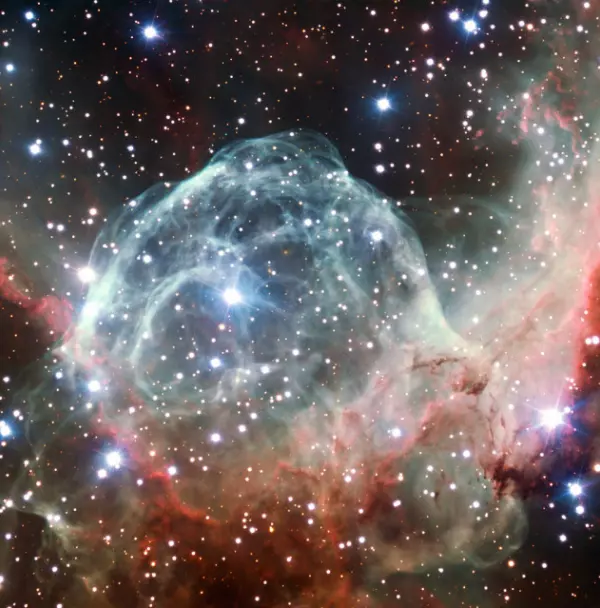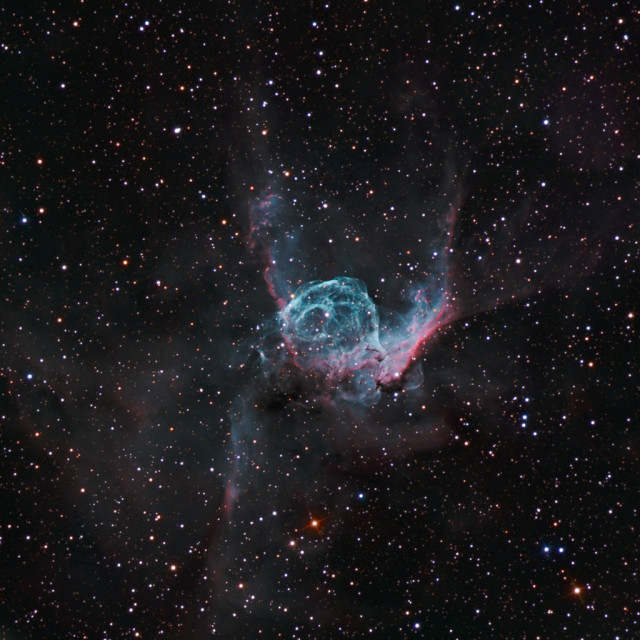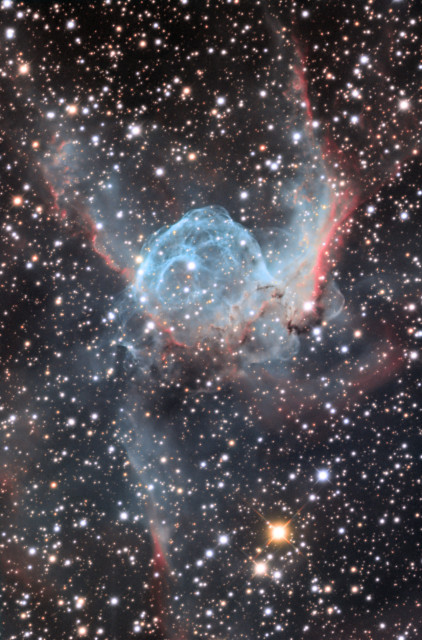Thor’s Helmet is an emission nebula located in the southern constellation Canis Major. Its designation in the New General Catalogue is NGC 2359. The nebula is 30 light years in size and lies at a distance of 11,960 light years from Earth. It was named Thor’s Helmet because its bubble shape and filaments resemble the depictions of the Norse god’s helmet.
The nebula is located about 8 degrees to the northeast of Sirius, the brightest star in the sky. The central star of Thor’s Helmet is the Wolf-Rayet star WR 7 (HD 56925, HIP 35 378). WR 7 is a large, bright star located near the centre of the helmet. The star is believed to be about 280,000 times brighter than the Sun, 16 times more massive and 1.41 times larger. It has a surface temperature of 112,000 K and is about 20 million years old.
Wolf-Rayet stars are evolved, exceptionally hot and luminous stars in the last stage of their life, that are rapidly losing mass as a result of a strong, high-speed stellar wind. The speed of WR 7’s stellar wind is estimated at 1,545 km/s. The star will end its life as a brilliant supernova in the relatively near future.
Thor’s Helmet was formed as a result of WR 7 expelling its outer layers. The overall helmet shape is a result of interaction of the expanding bubble of expelled material with giant molecular clouds in the area. The ionising radiation of WR 7 is responsible for the nebula’s glow, visible in wavelengths from radio to X-ray.
Different parts of Thor’s Helmet are expanding at different rates, estimated to be from 10 km/s to 30 km/s or more. The different rates of expansion put the estimates of the nebula’s age in the range between 78,500 and 236,000 years.
Thor’s Helmet can be seen in 6-inch or smaller telescopes, but it only appears as a fuzzy patch in smaller instruments. A 10-inch telescope will show some of the arcs extending away from the nebula’s central region.

This VLT image of the Thor’s Helmet Nebula was taken on the occasion of ESO’s 50th Anniversary, 5 October 2012, with the help of Brigitte Bailleul — winner of the Tweet Your Way to the VLT! competition. The observations were broadcast live over the internet from the Paranal Observatory in Chile. This object, also known as NGC 2359, lies in the constellation of Canis Major (The Great Dog). The helmet-shaped nebula is around 15 000 light-years away from Earth and is over 30 light-years across. The helmet is a cosmic bubble, blown as the wind from the bright, massive star near the bubble’s centre sweeps through the surrounding molecular cloud. Image: ESO/B. Bailleul
Thor’s Helmet – NGC 2359
Constellation: Canis Major
Coordinates: 07h 18m 30s (right ascension), -13°13.8′ (declination)
Distance: 11,960 light years (3,670 parsecs)
Apparent magnitude: 11.45
Angular size: 8′ x 8′
Designations: Thor’s Helmet, NGC 2359, Sharpless 2-298, GUM 4, LBN 227.66-00.09, SH 2-298, GRS 227.80 -00.20, LBN 1041, RCW 5

NGC 2359, lies in the constellation of Canis Major (The Great Dog). The helmet-shaped nebula is around 15 000 light-years away from Earth and is over 30 light-years across. The helmet is a cosmic bubble, blown as the wind from the bright, massive star near the bubble’s centre sweeps through the surrounding molecular cloud. Image: Martin Rusterholz in CXIELO
